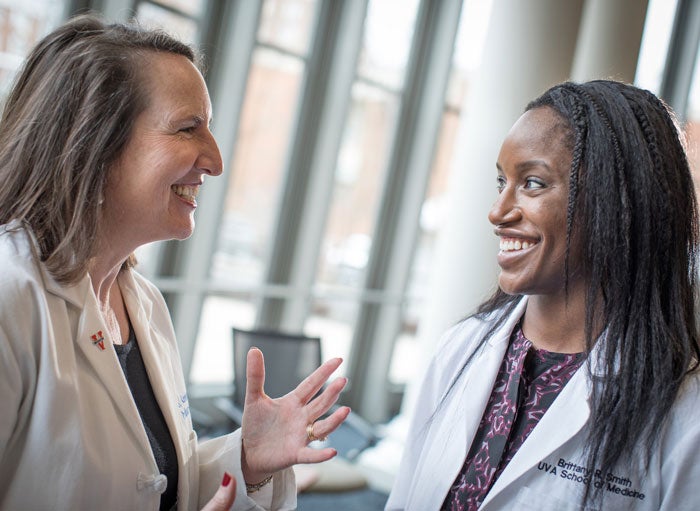UVA School of Medicine or Hogwarts? Q&A With a College Dean and Third-Year Student

Meg Keeley, MD, Dean of Dunglison College, and third-year Dunglison College medical student Brittany Smith
It’s not Hogwarts and there’s no magic talking hat, but new School of Medicine students do experience a “sorting” into one of four “houses,” known as colleges, upon their arrival at UVA. It’s an education format known as a learning community, or, among some students, as the Harry Potter model.
These colleges aren’t actual places—instead, they are organized clusters of students who stay together for the full four years, building bonds and strengthening skills.
The Four Colleges at UVA
- Robley Dunglison College: As the first professor of anatomy and medicine at UVA, Dr. Dunglison was also Thomas Jefferson’s personal physician. He is known as the “Father of American Physiology,” largely because of his textbook Human Physiology (1832). Dean: Meg Keeley, MD
- Thomas Hunter College: A pioneer in bioethics, Dr. Hunter was dean of UVA’s School of Medicine from 1953 -1965 and subsequently served as vice president for medical affairs. He returned to the faculty and headed a nationally recognized program in bioethics. Dean: John Densmore, MD, PhD
- Vivian Pinn College: Dr. Pinn was both the only African American and the only woman in the UVA School of Medicine class of 1967. A pathologist and retired director of the NIH’s Office of Research on Women’s Health, Dr. Pinn is also known as a firm advocate for women and underrepresented minorities in medicine. Dean: Christine Peterson, MD
- Walter Reed College: In 1869, at age 18, Walter Reed became the youngest graduate of UVA School of Medicine. Reed joined the Army Medical Corps in 1875 and is most well-known for leading the team that made the discovery that a mosquito was responsible for the transmission of yellow fever. Dean: Sean Reed, MD
What are the benefits? We asked Meg Keeley, MD, Dean of Dunglison College, and third-year Dunglison College medical student Brittany Smith to share their perspectives.
Q: What’s the big idea behind this sorting?
Keeley: Basically, it’s a way to improve the learning environment by forming smaller learning communities from the large class as a whole. The framework provides a social context for learning and allows for more consistent oversight of clinical performance and professional development. It gives students better access to their dean as well as peer mentors, and a stronger support group.
Smith: For the students, the college creates a micro-community—a group where you feel like you belong. At the beginning, you have some college “game” competitions that create opportunities to get to know each other. It keeps the more timid kids from falling through the cracks.
Q: What role do the deans play within their respective colleges?
Keeley: The dean is the first point of contact for any student, on any school-related issue. We are the students’ advocates in every situation—academic progress, health issues, career counseling, and more. We’re there the first time they don their white coats, and we’re there for their hooding at graduation. I can tell you, a lot of stuff happens between the white coat ceremony and graduation!
Smith: When Dean Keeley sees me, she always asks me how I’m doing. That makes it more likely for me to reach out to her when I need advice. I’ve lost some family members since I started school, and she was there to support me, even responding to late-night emails. She’s always an advocate for all of us.
Q: What are some of the most meaningful moments within the colleges?
Keeley: Graduation. It’s always bittersweet, but it’s amazing to think that I’ve had an impact on these students and their successes. Sometimes the relationship extends beyond medical school, and I hear from former students who still want my opinion. Frankly, it is a real privilege to work with the other deans and witness our students becoming physicians.
Smith: Time spent with the close friends I’ve made. There are four to six of us who study together and even vacation together. We share the same quirky sense of humor and do things like text each other silly mnemonics to help remember disease processes.
Q: What’s next?
Keeley: Starting this fall, each new student will follow a real patient from the beginning of medical school with the supervision of a faculty coach. That adds another new learning concept that’s really exciting.
Smith: For me, in fourth year, I’ll be doing electives, mostly in pediatrics. Some will be local, and I’m hoping to get into the Spanish immersion program in Guatemala. I may not be seeing my med friends often, but I know we’ll stay in touch.
How the College System Works: A Quick Summary
Each year, the School of Medicine welcomes about 160 new students, who are divided into four colleges, each with its own dean. Every year, each of the four colleges gets about 40 new students (and loses about 40 at graduation). At any given time, each College Dean is responsible for about 160 students.
Learning communities in medical education have become more common in the last few years, but UVA has expanded on some ideas. For instance, it’s typical for new students to spend their first 18 months learning fundamental clinical skills under the guidance of a mentor, or coach, within a small group of 6-7 students. UVA’s colleges are formed around these groups, keeping those more intensive learning teams—and their coaches—together within the larger group. Uniquely, at UVA, the college groups also rotate through their clinical clerkship year on the same schedule, allowing students to maintain their peer relationships as they function together in patient care settings.
For more details on this learning method, visit the Learning Communities Institute.
(Originally published in UVA PULSE Online)
Filed Under: Media Highlights

Comments